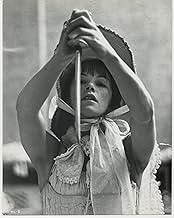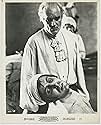ÉVALUATION IMDb
7,5/10
2,7 k
MA NOTE
Ajouter une intrigue dans votre langueIn an insane asylum, Marquis de Sade directs Jean Paul Marat's last days through a theater play. The actors are the patients.In an insane asylum, Marquis de Sade directs Jean Paul Marat's last days through a theater play. The actors are the patients.In an insane asylum, Marquis de Sade directs Jean Paul Marat's last days through a theater play. The actors are the patients.
- Prix
- 2 victoires et 1 nomination au total
Robert Langdon Lloyd
- Jacques Roux
- (as Robert Lloyd)
Histoire
Le saviez-vous
- AnecdotesCharenton, the asylum depicted in the film, was established in 1645 and still exists and is still in use, although it is now called the Esquirol Hospital (l'Hôpital Esquirol), named for Jean-Étienne Dominique Esquirol, a French psychiatrist who ran the hospital in the 19th Century.
- Citations
Marquis de Sade: And what's the point of a revolution without general copulation?
- Générique farfeluThe opening credits - the play's title, stage credits and the actors appearing in the film - pop on the screen, one word at a time, until it is filled. The closing credits - the film's production staff - start off with a full screen of words, and they then pop off the screen, one word at a time, until it is completely empty...just as it was when the film began.
- Autres versionsThe first VHS video release of the film, through Water Bearer Films, includes an expositional opening monologue over the opening titles on black.
- ConnexionsFeatured in Changing Stages (2000)
Commentaire en vedette
The Persecution and Assassination of Jean-Paul Marat as Performed by the Inmates of the Asylum of Charenton Under the Direction of the Marquis de Sade (1967/Peter Brook) **** out of ****
"He who kills without passion, is a machine."- Marquis de Sade (Patrick Magee)
What does one look for in a film? I suppose it has something to do with personal interest, but the reason why I was fascinated with the film mentioned above, was because of its abnormally large title. As I was strolling through Blockbuster today, I noticed that it carried this film on DVD. And I thought to myself, "Isn't it rare that my local Blockbuster is housing such a rare 60's arthouse film?". So I took advantage of it, and rented the movie. And this is what I found within it...
Never before has a title been so self explanatory. It serves as the film's plot description. It is basically a filmed play about the French Revolution and the last days of Jean-Paul Marat (Ian Richardson). The catch is: It is performed by patients of a mental hospital in France (in 1808). And it is directed and acted in by a famous patient at the hospital: The Marquis de Sade. It is performed to the Administrator and his family, and many local citizens who care to watch. The point of the show is to prove that the hospital's rehabilitation methods are working, but de Sade has a far more ambitious goal than that. And the play is constantly interrupted by the administrator, who feels it should be more "politically correct" for the recent times. But after the second act, the inmates have secretly taken over, and he is forced just to watch in horror, as are we...the audience.
It is very hard to classify this film. At some points, it is a drama. At other points, it is a thriller, mystery, horror, comedy, and even musical (the musical numbers are very strange). But for the most part, it is a two hour history lesson. All the performances are excellent, and haunting (especially Glenda Jackson's performance). The film has a bizarre tone about it, and is easily the most eerie film I have ever scene. When I called it a history lesson, you might have lost interest right then. But, all the actors (especially the narrator who speaks only in rhymes), looks directly into the camera as they speak. It is as if they are talking to you, and as if you are the only one watching. This gives you the feeling that you must sit up and listen, or they will be angry with you.
"Marat/Sade" is the most unique, and most ghostly film I have ever scene. I only recommend it to fans of theater, and of course film buffs. Though the film requires your greatest attention, it is oddly rewarding.
-30-
"He who kills without passion, is a machine."- Marquis de Sade (Patrick Magee)
What does one look for in a film? I suppose it has something to do with personal interest, but the reason why I was fascinated with the film mentioned above, was because of its abnormally large title. As I was strolling through Blockbuster today, I noticed that it carried this film on DVD. And I thought to myself, "Isn't it rare that my local Blockbuster is housing such a rare 60's arthouse film?". So I took advantage of it, and rented the movie. And this is what I found within it...
Never before has a title been so self explanatory. It serves as the film's plot description. It is basically a filmed play about the French Revolution and the last days of Jean-Paul Marat (Ian Richardson). The catch is: It is performed by patients of a mental hospital in France (in 1808). And it is directed and acted in by a famous patient at the hospital: The Marquis de Sade. It is performed to the Administrator and his family, and many local citizens who care to watch. The point of the show is to prove that the hospital's rehabilitation methods are working, but de Sade has a far more ambitious goal than that. And the play is constantly interrupted by the administrator, who feels it should be more "politically correct" for the recent times. But after the second act, the inmates have secretly taken over, and he is forced just to watch in horror, as are we...the audience.
It is very hard to classify this film. At some points, it is a drama. At other points, it is a thriller, mystery, horror, comedy, and even musical (the musical numbers are very strange). But for the most part, it is a two hour history lesson. All the performances are excellent, and haunting (especially Glenda Jackson's performance). The film has a bizarre tone about it, and is easily the most eerie film I have ever scene. When I called it a history lesson, you might have lost interest right then. But, all the actors (especially the narrator who speaks only in rhymes), looks directly into the camera as they speak. It is as if they are talking to you, and as if you are the only one watching. This gives you the feeling that you must sit up and listen, or they will be angry with you.
"Marat/Sade" is the most unique, and most ghostly film I have ever scene. I only recommend it to fans of theater, and of course film buffs. Though the film requires your greatest attention, it is oddly rewarding.
-30-
- FranktheRabbit
- 18 déc. 2003
- Lien permanent
Meilleurs choix
Connectez-vous pour évaluer et surveiller les recommandations personnalisées
- How long is Marat/Sade?Propulsé par Alexa
Détails
- Date de sortie
- Pays d’origine
- Langue
- Aussi connu sous le nom de
- Die Verfolgung und Ermordung Jean-Paul Marats dargestellt durch die Schauspielgruppe des Hospizes zu Charenton unter der Anleitung des Herrn de Sade
- Lieux de tournage
- sociétés de production
- Consultez plus de crédits d'entreprise sur IMDbPro
Contribuer à cette page
Suggérer une modification ou ajouter du contenu manquant

Lacune principale
By what name was Marat/Sade (1967) officially released in Canada in English?
Répondre






























